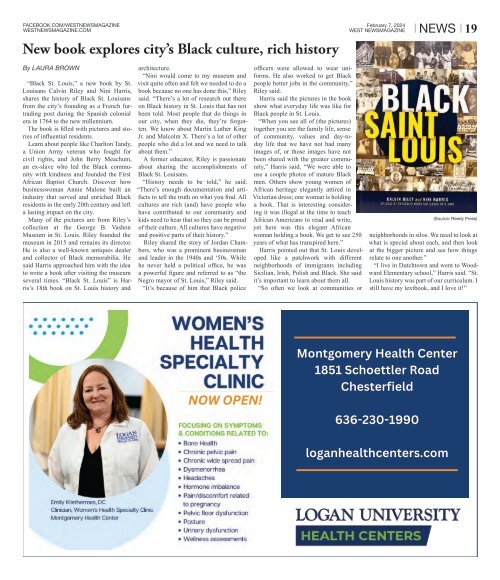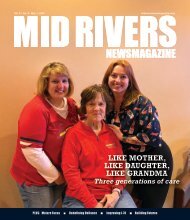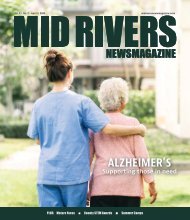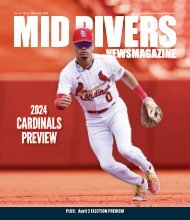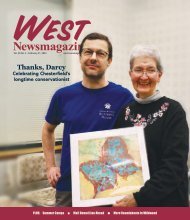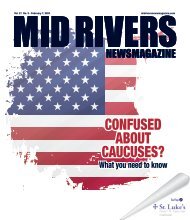West Newsmagazine 2-7-24
Local news, local politics and community events for West St. Louis County Missouri.
Local news, local politics and community events for West St. Louis County Missouri.
Create successful ePaper yourself
Turn your PDF publications into a flip-book with our unique Google optimized e-Paper software.
FACEBOOK.COM/WESTNEWSMAGAZINE<br />
WESTNEWSMAGAZINE.COM<br />
New book explores city’s Black culture, rich history<br />
February 7, 20<strong>24</strong><br />
WEST NEWSMAGAZINE<br />
I NEWS I 19<br />
By LAURA BROWN<br />
“Black St. Louis,” a new book by St.<br />
Louisans Calvin Riley and Nini Harris,<br />
shares the history of Black St. Louisans<br />
from the city’s founding as a French furtrading<br />
post during the Spanish colonial<br />
era in 1764 to the new millennium.<br />
The book is filled with pictures and stories<br />
of influential residents.<br />
Learn about people like Charlton Tandy,<br />
a Union Army veteran who fought for<br />
civil rights, and John Berry Meachum,<br />
an ex-slave who led the Black community<br />
with kindness and founded the First<br />
African Baptist Church. Discover how<br />
businesswoman Annie Malone built an<br />
industry that served and enriched Black<br />
residents in the early 20th century and left<br />
a lasting impact on the city.<br />
Many of the pictures are from Riley’s<br />
collection at the George B. Vashon<br />
Museum in St. Louis. Riley founded the<br />
museum in 2015 and remains its director.<br />
He is also a well-known antiques dealer<br />
and collector of Black memorabilia. He<br />
said Harris approached him with the idea<br />
to write a book after visiting the museum<br />
several times. “Black St. Louis” is Harris’s<br />
18th book on St. Louis history and<br />
architecture.<br />
“Nini would come to my museum and<br />
visit quite often and felt we needed to do a<br />
book because no one has done this,” Riley<br />
said. “There’s a lot of research out there<br />
on Black history in St. Louis that has not<br />
been told. Most people that do things in<br />
our city, when they die, they’re forgotten.<br />
We know about Martin Luther King<br />
Jr. and Malcolm X. There’s a lot of other<br />
people who did a lot and we need to talk<br />
about them.”<br />
A former educator, Riley is passionate<br />
about sharing the accomplishments of<br />
Black St. Louisans.<br />
“History needs to be told,” he said.<br />
“There’s enough documentation and artifacts<br />
to tell the truth on what you find. All<br />
cultures are rich (and) have people who<br />
have contributed to our community and<br />
kids need to hear that so they can be proud<br />
of their culture. All cultures have negative<br />
and positive parts of their history.”<br />
Riley shared the story of Jordan Chambers,<br />
who was a prominent businessman<br />
and leader in the 1940s and ‘50s. While<br />
he never held a political office, he was<br />
a powerful figure and referred to as “the<br />
Negro mayor of St. Louis,” Riley said.<br />
“It’s because of him that Black police<br />
officers were allowed to wear uniforms.<br />
He also worked to get Black<br />
people better jobs in the community,”<br />
Riley said.<br />
Harris said the pictures in the book<br />
show what everyday life was like for<br />
Black people in St. Louis.<br />
“When you see all of (the pictures)<br />
together you see the family life, sense<br />
of community, values and day-today<br />
life that we have not had many<br />
images of, or those images have not<br />
been shared with the greater community,”<br />
Harris said. “We were able to<br />
use a couple photos of mature Black<br />
men. Others show young women of<br />
African heritage elegantly attired in<br />
Victorian dress; one woman is holding<br />
a book. That is interesting considering<br />
it was illegal at the time to teach<br />
African Americans to read and write,<br />
yet here was this elegant African<br />
woman holding a book. We get to see 250<br />
years of what has transpired here.”<br />
Harris pointed out that St. Louis developed<br />
like a patchwork with different<br />
neighborhoods of immigrants including<br />
Sicilian, Irish, Polish and Black. She said<br />
it’s important to learn about them all.<br />
“So often we look at communities or<br />
(Source: Reedy Press)<br />
neighborhoods in silos. We need to look at<br />
what is special about each, and then look<br />
at the bigger picture and see how things<br />
relate to one another.”<br />
“I live in Dutchtown and went to Woodward<br />
Elementary school,” Harris said. “St.<br />
Louis history was part of our curriculum. I<br />
still have my textbook, and I love it!”<br />
NOW OPEN!<br />
Montgomery Health Center<br />
1851 Schoettler Road<br />
Chesterfield<br />
636-230-1990<br />
loganhealthcenters.com


